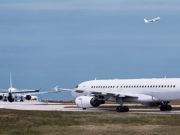
Cargo aircraft accounted for 13 accidents — 29 percent of the total of 49 commercial air transport accidents — in 2017, according to data compiled by the International Air Transport Association (IATA).
Of the total of six fatal accidents involving commercial airliners in 2017, four were in cargo airplanes, and those four crashes were responsible for 12 of the 19 on-board fatalities recorded in 2017, IATA said in its Safety Report 2017, published earlier this year.
Tables 1 and 2 show that more than twice as many turboprop cargo aircraft — nine — as jet cargo aircraft — four — were involved in crashes in 2017. Of these, three jet aircraft and six turboprop aircraft were classified as hull losses, defined by IATA as accidents in which an aircraft is “damaged beyond repair or the costs related to the repair [are] above the commercial value of the aircraft.”
| Fleet Size | Hull Loss | Hull loss/ 1,000 Aircraft |
Substantial Damage | Substantial Damage/ 1,000 Aircraft |
Total Accidents | Accident/ 1,000 Aircraft |
|
|---|---|---|---|---|---|---|---|
|
Note: Fleet size includes both in-service and stored aircraft operated by commercial airlines. Cargo aircraft are defined as dedicated cargo, mixed passenger/cargo (combi) or quick-change configurations. Source: International Air Transport Association |
|||||||
| Cargo | 2,123 | 3 | 1.41 | 1 | 0.47 | 4 | 1.88 |
| Passenger | 24,027 | 1 | 0.04 | 20 | 0.83 | 21 | 0.87 |
| Total | 26,150 | 4 | 0.15 | 21 | 0.80 | 25 | 0.96 |
| Fleet Size | Hull Loss | Hull loss/ 1,000 Aircraft |
Substantial Damage | Substantial Damage/ 1,000 Aircraft |
Total Accidents | Accident/ 1,000 Aircraft |
|
|---|---|---|---|---|---|---|---|
|
Note: Fleet size includes both in-service and stored aircraft operated by commercial airlines. Cargo aircraft are defined as dedicated cargo, mixed passenger/cargo (combi) or quick-change configurations. Source: International Air Transport Association |
|||||||
| Cargo | 1,279 | 6 | 4.691 | 3 | 2.346 | 9 | 7.04 |
| Passenger | 4,288 | 3 | 0.7 | 8 | 1.87 | 11 | 2.57 |
| Total | 5,567 | 9 | 1.617 | 11 | 1.976 | 20 | 3.59 |
The data prompted IATA Senior Vice President for Safety and Flight Operations Gilberto Lopez Meyer to say that cargo operations are “in need of additional attention” to improve their safety record.
Data for the five-year period from 2013 through 2017 showed 75 cargo accidents that resulted in 119 fatalities. Forty percent of the aircraft involved were jet airplanes and 57 percent were turboprops, the report said, noting that the total did not add to 100 percent because of rounding.
In a breakdown by region (Figure 1), more cargo planes crashed in Africa (21) than in any other region, followed by North America (15), the Asia Pacific (13) and Latin America and the Caribbean (10).
Figure 1 — Number of Accidents per Region, 2013–2017
Note: An Antonov An-74 hard landing at the Barneo Ice Base (international waters) near the North Pole.
Source: International Air Transport Association
Loss of control–in flight (LOC-I) accidents occurred more often than accidents of any other category during the five-year period, accounting for 16 percent of all accidents involving cargo airplanes, the report said (Figure 2). Controlled flight into terrain was the second-highest category, at 11 percent.
Figure 2 — Accident Category Frequency and Fatality Risk, 2013–2017
Note: Since the sector count broken down by cargo flights is not available, rates could not be calculated. The fatality risk rate was therefore substituted by a fatality ratio value, which is the total number of fatalities divided by the total number of people carried. Although this removes the effect of the percentage of people killed in each fatal crash, it can still be used as a reference to determine which accident categories contributed the most to the number of fatalities on cargo flights. Accident categories with no fatalities are not displayed.
Source: International Air Transport Association
The report noted that because the number of sectors flown by cargo aircraft was not available, accident rates in these categories could not be calculated. Therefore, Figure 2 shows the fatality ratio, which IATA defines as “the total number of fatalities divided by the total number of people carried.”
An examination of contributing factors to cargo aircraft accidents that occurred from 2013 through 2017 found that the most common latent condition was regulatory oversight, the most common threat was an aircraft malfunction, and the most common flight crew error was manual handling/flight controls; each one was cited in 37 percent of the cargo accidents, the report said. The most common undesired aircraft state was “long/floated/bounced/firm/off-center/crabbed landing,” cited in 27 percent of accidents, and the “most common countermeasure absent in the accidents” was overall crew performance.
Runway Excursions
The most common accident category for cargo flights from 2013 through 2017 involved runway and taxiway excursions, followed by LOC-I and gear-up landings/landing gear collapses, the report said (Figure 3).
Figure 3 — Accident Category Distribution, 2013–2017
Source: International Air Transport Association
Although more total accidents occurred during landing than in any other phase of flight, more fatal accidents occurred during initial climb, the report said (Figure 4).
Figure 4 — Accidents per Phase of Flight, 2013–2017
Source: International Air Transport Association
The report singled out cargo operations as one area in need of improvement, noting that of six fatal accidents in 2017, four involved cargo flights, and cargo accidents were responsible for more fatalities, including more fatalities on the ground, than passenger aircraft accidents.
“While operators should continue to train to eliminate these types of accidents, accidents in the runway environment must not be ignored, even though the fatality risk is low,” the report said.
The accident responsible for more fatalities than any other crash in 2017 involved a myCargo Airlines Boeing 747 that struck the ground in a residential area near Bishkek Manas International Airport in Kyrgyzstan on Jan. 16, killing all four people in the airplane and 35 people on the ground. The 747 was destroyed by the impact and subsequent fire.
Major Safety Issues
The document added that, in the ground operations/cargo category, the top safety issues involve loading errors/integrity and the loadsheet, along with third-party oversight of cargo operations.
The document also identified as emerging/evolving safety issues two areas that are especially relevant to cargo operations — the increasing use of “smart baggage” (that is, luggage with built-in lithium batteries to allow the charging of personal electronic devices (PEDs) or the powering of motorized wheels on the suitcase) and the carriage of lithium batteries. IATA member airlines, along with a number of non-members, carry smart luggage only if the battery can be removed from the bag, and the International Civil Aviation Organization is studying issues associated with PEDs in checked baggage.
Note
- IATA. Safety Report 2017. April 2018.


